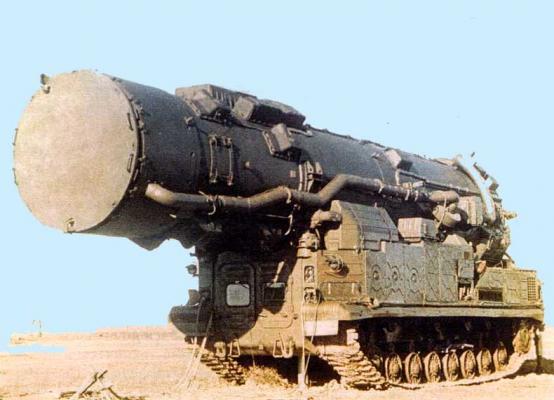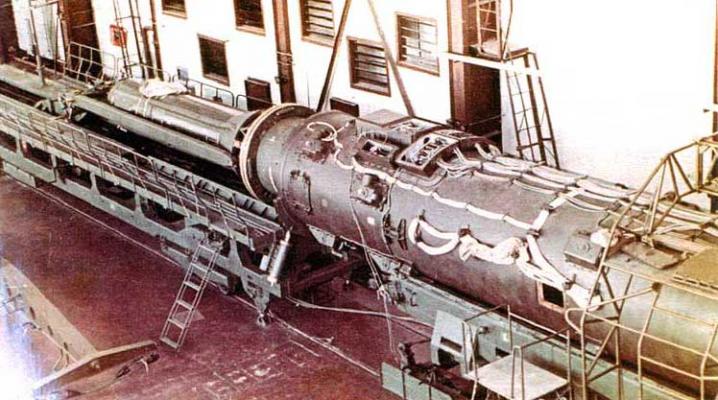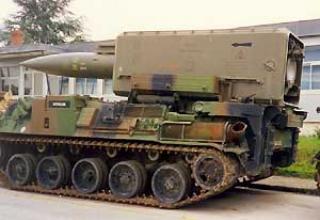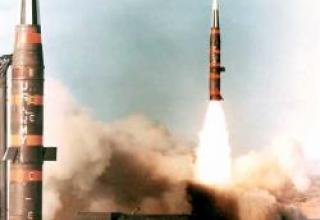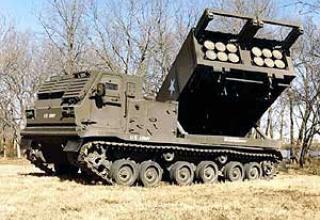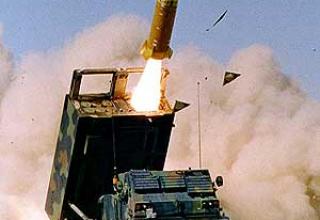Rocket complexes 15P096 and 15P696 (stationary silo and mobile) for a medium-range ballistic missile 8K96 were developed under the decree of the CPSU Central Committee and the USSR CM dated April 4, 1961 № 316-137.
The creation of these complexes was one of the steps to implement in practice the idea of a unified missile system based on the intercontinental missile 8K98 (RT-2). By combining the stages of this missile was planned to create missiles at intermediate ranges (2 and 3 stages of the missile formed a missile 8K96, 1 and 3 stages - 8K97) for various purposes and basing. Launches 15U64 stationary complex 15P096 were designed in the Central Design Bureau-34 chief designer V.F.Lender, and in the number of two pieces were made by the plant "Bolshevik" for installation in the construction facilities built on the GTSP-4, where the LKI. However, the work was stopped at the stage of installation of launchers. In the future the works were carried out only on the 15P696 mobile complex.
The work on the 15P696 missile system was headed by P.A.Tyurin, Chief Designer of the Central Design Bureau-7 (DO of the Arsenal Plant), and the launch complex was headed by V.V.Chernetsky, Chief Designer of the Central Design Bureau-34 (DOB-34). The work was forced to be divided into two stages. At the first stage, in 1962, Design Bureau-2 of the Central Design Bureau-34 developed a conceptual design of the complex, as well as with the participation of Kirov plant Design Bureau-3 under the guidance of Chief Designer Zh.Ya.Kotin developed working drawings of the launchers. The Kirovske plant produced 2 sets of launchers. Tests were to begin in the 3rd quarter of 1963. However, due to delays in fuel development by the USSR Government Decree of 16 June 1963, the test period was postponed until the first positive tests of 8K98 rocket. After that, all work on 8K96 was suspended. The first launcher is now interesting only because it participated in the military parade on Red Square in Moscow in 1966.
At the second stage, in August 1965, the customer issued additions to the TTT, which required finalization of the sketch design of the complex made in 1962. According to the additions to the TTT, the rocket was to be launched directly from the transport and launch container. The start date of flight tests remained the same - the 2nd quarter of 1966. Changes to the TTT required the development of a new launcher, new structure and composition of the complex. The scope of work was so large that it was obvious that we would not be able to perform the tests in time. Therefore, in agreement with the customer, the tests were started with a reduced composition of equipment, as the equipment was ready, the complex was replenished to the full composition.
Testing of the complex started in 1967. After the end of the State Tests in 1970 the complex was accepted to the MoD for pilot operation and operated in Belarus.
Production of RT-15 missiles was launched at the Frunze Leningrad Machine Building Plant No.7. Mass production of missiles was stopped in January 1969.
In the west the complex was designated SS-X-14 "Scamp/Scapegoat".
Composition:
The 15P696 mobile combat missile system was to provide autonomous combat duty, automated prelaunch training and salvo launch of six missiles at any time of year and day, without special preparation of combat position. The complex was to establish the principle of short-term combat duty on one of the combat positions with subsequent relocation to a new combat position, full autonomy and automation of power supply, aiming and launching from constant or full combat readiness.
The mobile missile system 15P696 was part of the mobile missile system:
- 6 15U59 self-propelled launchers with 8K96 missiles in 15Y25 transport and launch containers (see diagram);
- combat control vehicle 15H809;
- two "A" and "B" communication vehicles;
- mobile diesel-electric power stations 15H964.
Ground equipment included in the technical position:
- transhipment unit 15T81;
- container loading unit 15T79;
- transport unit 15T84;
- isothermal docking machine 15T21P;
- machines for routine testing of control system and sighting system.
The two-stage 8K96 medium-range solid fuel ballistic missile was equipped with a monoblock detachable in flight nuclear warhead (FM) of 600ct power. The stage engines were made in different diameters, the nozzle blocks had four cut control nozzles each, consisting of fixed and movable parts. For docking the feet, a connecting compartment of the truss construction similar to 8K98 rocket was used. This design allowed gases from a running second stage engine to escape freely when the steps were separated. The first and second stage engines had monoblock charges on mixed solid fuel PAL-17/7, bonded to the engine housing and made by injection molding directly into the engine housing. The engine charges based on butyl rubber and ammonium perchlorate with the addition of powdered aluminum were developed by the Altai Research Institute of Chemical Technology. Nozzle block D-1, steering drives and part of the control system instruments were placed in the tail compartment of the first stage, which had the form of a truncated cone. To increase the stability of the rocket at the initial stage of the flight, the tail compartment of the first stage was equipped with four grating stabilizers.
The missile's range was controlled by the second stage engine thrust cut-off device: the cut-off units on the upper bottom of the engine were opened with the help of pyro-charges, which created the necessary counter-rotation. To reduce the dispersion of the effect impulse, switching off the stage engine was carried out in two stages: first, opened two nodes of the cut-off of the four, then the engine moved to a lower thrust, and then, with some time delay, the remaining two nodes of the cut-off finally zeroed the thrust. After that there was a separation of the head unit with a special charge, and it continued to fly independently to the target on a ballistic trajectory.
The missile was installed an autonomous inertial control system, which controlled the flight of the missile from the moment of launch until the transition to the uncontrolled flight of the head unit. The control system was equipped with counting and resolution devices. Most of the control devices were placed in the instrument compartment.
The 15U59 self-propelled launcher was based on the T-10 heavy tank. The PU had a rather high cross-country ability, but could only be operated off hard roads. The disadvantages of the complex were also a short travel time - about 3000-5000 km and complexity of operation (it was difficult to access many chassis elements, replacement of some special systems required the removal of adjacent systems, etc.). Transportable and launching fiberglass plastic containers, providing transportation, storage during the entire period of operation, temperature control and rocket launch, were designed in the Central Design Bureau-34 with the involvement of SKTB (Khotkovo, Moscow region) in terms of technology for manufacturing fiberglass structures.
The ground equipment included in the technical position was developed by the Motor Design Bureau (Chief Designer V.A.Rozhdov). An isothermal car 15T83 and a support car 15T89 were created for transportation of the container of the Kalininsky Railcar-Building Plant Design Bureau (Chief Designer L.D. Novikov).
All loading and unloading operations were performed by craneless method, which had a positive impact on the convenience and safety of operation.
Characteristics:
| General characteristics | |
| Maximum range of fire, km | 2500 |
| Circular probable deviation,m | 900 |
| 8K96 missile | |
| Launching weight of the rocket, tc | 16 |
| Weight of the head end, kgs | 500 |
| Maximum housing diameter, m | 1.49 |
| Length, m | 11.93 |
| Length 1 step, m | 4.74 |
| Length 2 steps, m | 6.77 |
| Length of TPK, m | 12.7 |
| TPK diameter, m | 2.1 |
| Remote Control Features | |
| Remote control pulling, shh: - Stage I engines - second stage engines |
42 22 |
| Specific pulse, s: - Stage I motor - second stage engines |
237/263 271 |
| It's work time, s: - stage I motor - second stage engines |
60 45 |
Testing:
As a technical position was used Pl.105 GCP-4 (Kapustin Yar), created earlier for missiles 8K95 and 8K98, which had an assembly and test case with all necessary equipment and a laboratory building. On pl. 105 all tests and prelaunch checks of the rocket in the vertical position of the container, after which the launcher in camping position was moved to Pl. 84 for the production of launches. An underground command post in the centre of the site was used to house the equipment and the personnel directly involved in the launch of the missile.
On 4 December 1966, the first launch tests of the missile were carried out, confirming the possibility of switching to the LKI. February 9, 1967 the successful first flight test of the missile on the functioning of its systems was carried out, which served as a transition to the State Tests. The final stage was carried out as a part of 3 launchers 15U59, 15H809 combat control machine, 15B51 position preparation machine, communication center consisting of 3 machines, two diesel power plants and transport and docking machines 15T79, 15T81, 15T84, 15T21P1, both in single launches and with working out the duty mode of the whole complex.
Sources:
- "КБ специального машиностроения: От артиллерийских систем до стартовых комплексов" (под редакцией Ушакова В.С.) .СПб, 2004.
- RT-15/RT-2P SS-14 SCAMP/SCAPEGOAT
- RT-15 /Encyclopedia Astronautica/
- Ударные "Темпы" конструктора Надирадзе /НВО/
